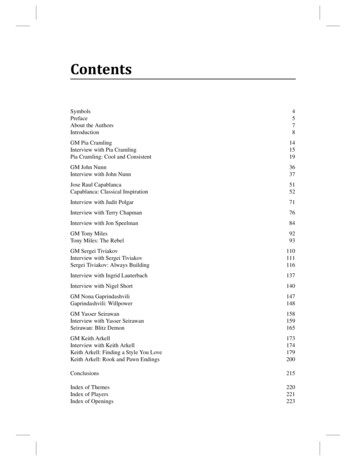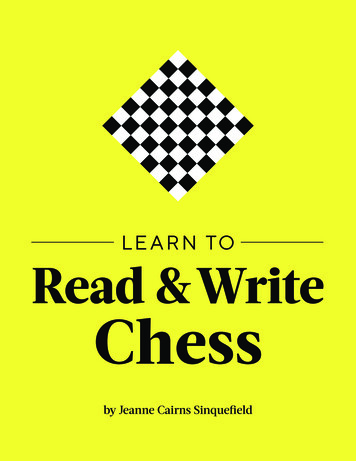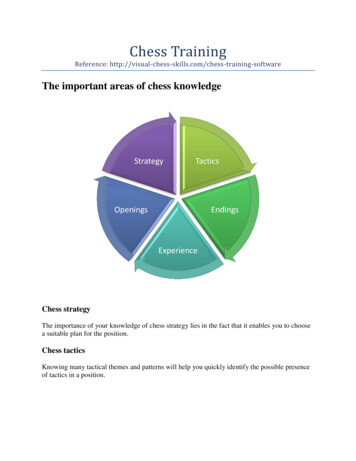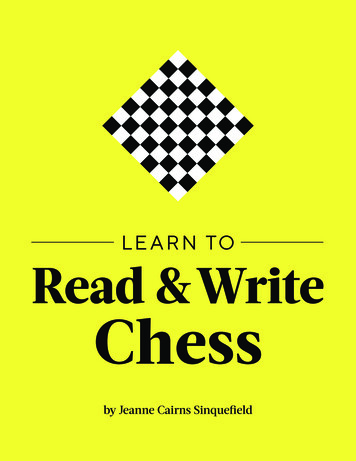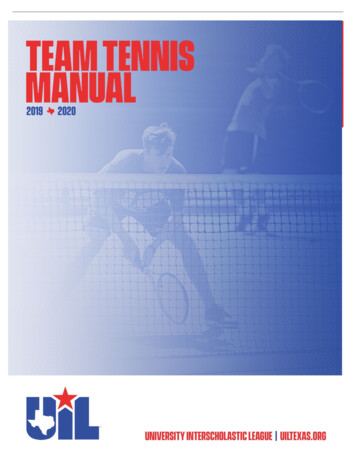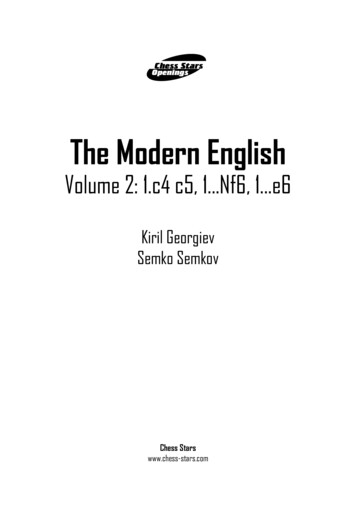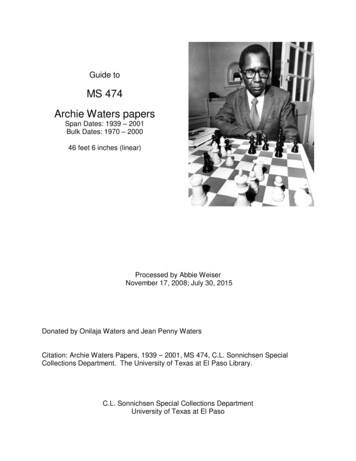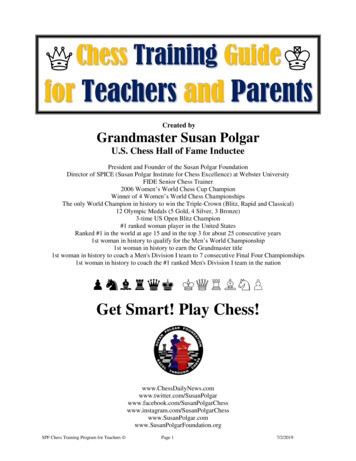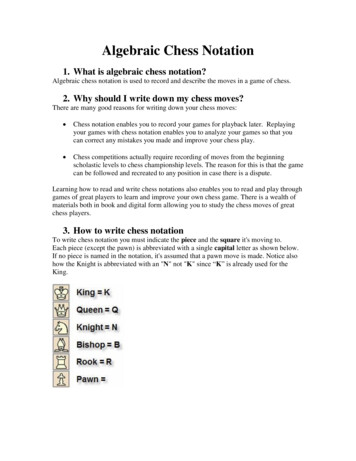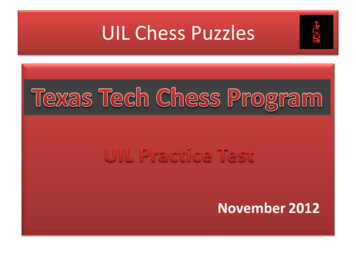
Transcription
UIL Chess Puzzle Practice Material This year’s UIL Chess Puzzle Test includes “solve the mate”positions similar to last year’s, but it also tests other kinds ofchess knowledge—knowledge that relates directly to otherschool skills, such as basic geometrical reasoning andcomputation, as well as critical and creative thinking. Each test will still be 20 questions, and one point will be givenfor each correct answer. No deductions will be made forincorrect answers. Students will be given 30 minutes tocomplete the test. Finishing early is not rewarded, even tobreak ties.
Tie-breaking procedures have been changed. Tie breaks willnow be decided by a more difficult test of 20 questions forwhich students have only 10 minutes. Incorrect answers arepenalized by subtracting 1.25 from the final score. So, on thetie-break test, it’s smart to be sure of an answer instead ofracing to circle answers to all the questions. Below are some study guides and sample questions thatreflect the general approach of this year’s UIL Chess PuzzleTest.
How to answer questions on the test. In order to answer many of the 20 questions on this test,you’ll need to know how “to read and write chess.” Thesystem is called “figurine algebraic notation,” or “FAN” forshort. It’s simple and depends on two easy systems, one forthe board and one for the pieces. Every square on the board has an “address” made up of aletter and a number.
Now we know that every square has a name.a8 b8 c8 d8 e8 f8g8h8a7 b7 c7 d7 e7 f7 g7 h7a6 b6 c6d6 e6 f6 g6 h6a5 b5 c5d5 e5 f5a4 b4 c4d4 e4 f4 g4 h4a3 b3 c3 d3Next we just have to learn how to read andwrite the names of the pieces that moveacross the board. See the next panel.a2 b2 c2a1 b1e3 f3g5 h5g3 h3d2 e2 f2 g2 h2c1 d1 e1 f1g1 h1
Every piece is indicated by alogical abbreviation:Letter Abbreviation(Algebraic Notation)KingKQueenQRookRBishopBKnightN(because “K” is already taken by the King!)Pawn(the file it’s on)(a-h)Figurine Symbol(Figurine AlgebraicNotation—used inthe puzzles test.)
In the first diagram, White just played 1.e4 In the second diagram, Black Played 1 . f68877665544332211
The United States Chess Federation offers a concise explanationof algebraic notation here:http://archive.uschess.org/beginners/read/But the test makes it even easier by using figurine algebraic—using outlines of the pieces rather than letters.Of course, you will also need to know how the pieces and pawnsmove. For a short but comprehensive course in moving the chesspieces, again go to the U.S. Chess Federation .pdfNow answer each of the questions below. Be sure to read eachquestion carefully and then choose the letter of the single, bestanswer from the choices below each question.
UIL Chess Puzzles1- What squares can the white pawn in the diagram move to?8a) e3, e4, and d3b) Only e4c) Only e3d) None of the above7654321ABCDEFGH
UIL Chess Puzzles2- The chessboard is square-shaped with eight squares on eachside. How many total squares does it have?a) 32b) 64c) 72d) None of the above
UIL Chess Puzzles3- Chess Players have names for the three kinds of “streets” on achessboard made by connecting squares. Which kind of “streets”do Bishops travel on?a) Ranksb) Filesc) Rowsd) Diagonals
UIL Chess Puzzles4- It’s Black’s move. White has just played e2-e4. Is it possible forBlack to capture the White pawn?a) Yes, by moving to e3and removing White’s pawn.b) Yes, by moving to d3and removing White’s pawn.c) Yes, by removing thepawn on e4 and keepingthe black pawn on d4.d) No, it’s not possible.
UIL Chess Puzzles5- White to move and mate in one.What’s the move?a)b)c)d)e7e1d8b1
UIL Chess Puzzles6- Which side has the greater value of material left on theboard?a) Whiteb) Blackc) Material is equal.d) It depends on whosemove it is.
UIL Chess Puzzles7- It’s White’s move. What move does he have to catch the pawnso that Black doesn’t wind up with a Queen!a)b)c)d)e6e5e7g6
UIL Chess Puzzles8- What move checkmates Black immediately?a)b)c)d)d7c8c1c3
UIL Chess Puzzles9- It’s White’s move, and he can force checkmate in two moves.What move does he have to playfirst to do this?a)b)c)d)h6 d6 d8 g5
UIL Chess Puzzles10- It’s White’s move, and he can force checkmate in two moves.What move does hehave to play first to do this?a)b)c)d)h4g4g3f6 Go to the next page to seethe correct answers andexplanations
UIL Chess PuzzlesChess Puzzle Practice Test:Correct answers and explanationsBelow we give the correct answers to the practice test. Feelfree to email us about questions or comments. We want tohear from you!texastechchess@ttu.edu
UIL Chess PuzzlesQuestion #1Correct Answer: aExplanation: On its initial move, the pawn can move one square aheador two moves ahead. Pawns capture diagonally, so taking the blackpawn on d3 is a possible third move.Question #2Correct Answer: bExplanation: The area of a rectangle is calculated by multiplying thelength by the width, using any consistent unit of measurement: 8 x 8 64.
UIL Chess PuzzlesQuestion #3Correct Answer: dExplanation: Bishops move only on the “slanted” rows ofsquares, the diagonals. The other “streets” are ranks and files.Question #4Correct Answer: aExplanation: This rule is called “en passant” or “in passing.” It is aspecial pawn capture that can be made immediately after anopponent moves a pawn two squares forward from its startingposition, and an enemy pawn could have captured it had itmoved only one square forward. But this optional capture has tobe made on the very next turn or the option is lost.
UIL Chess PuzzlesQuestion #5Correct Answer: cExplanation: By moving his rook on d1 to d8, White puts Black’sking in check, and that king can’t escape check. A king in checkmust get out of check immediately or it’s checkmate—andcheckmate ends the game. The side that is checkmated loses.There are three ways a king can get out of check, if it’s possible:Move out of check;Block the check with one of the king’s own pieces;Capture the checking piece.
UIL Chess PuzzlesIn this example, the black king can’t move out of check becausehe’s hemmed in by his own pieces. There is no friendly piecethat can block the check by the white rook. So Black’s last chanceis to capture White’s rook. But he can’t play 1. Bxe7xd8because his bishop is pinned to his king by the white bishop. SoBlack is checkmated.
UIL Chess PuzzlesQuestion #6Correct Answer: bExplanation: A simple way to explain the relative material values of the pieces is:Queen 9Rook 5Bishop 3Knight 3Pawn 1Kings aren’t counted in this way, since they are infinitely valuable.So in the position diagrammed, Black’s material adds up to 22. White’s material addsup to 18.
UIL Chess PuzzlesQuestion #7Correct Answer: bExplanation: White’s king must get in the “square of the pawn.”No other move catches the pawn before it reaches the oppositeside of the board and promotes. For an explanation of “The Ruleof the Square,” seehttp://en.wikipedia.org/wiki/King and pawn versus king endgame
UIL Chess PuzzlesQuestion #8Correct Answer: bExplanation: Moving the rook to c1 puts Black’s king in check,and he can’t escape because he is trapped on the back rank byhis own pawns. Black has no piece that can block the check, andhe can’t capture White’s rook. So it’s checkmate.
UIL Chess PuzzlesQuestion #9Correct Answer: cExplanation: By moving 1. Nd8 , White discovers check onBlack’s king with White’s queen. Black can’t capture White’squeen or block the check. So the black king must move. Becausef8 is covered by the white rook on f1, the king’s only move is 1. Kh8. Then White can follow up with 2. Rf8, checkmate.Another first move, 1. Nh6 will mate in three moves: 1. Kh8 2.Qg8! Rxg8 3. 3. Nf7 checkmate. But the challenge was to mate inonly two moves, and only answer “c” does that.
UIL Chess PuzzlesQuestion #10Correct Answer: dExplanation: 1. Nf6 ! forces the black king to move to play 1. Kh8, and then White follows up with 2. Qxh7 checkmate. After 1.Nf6 !, Black cannot capture the white knight with 1. gxf6because his g-pawn is pinned by the white rook on g2. So hisonly move to get out of check is 1. Kh8, which allows thecheckmate by the white queen.
UIL Chess Puzzle Practice Material This year's UIL hess Puzzle Test includes "solve the mate" positions similar to last year's, but it also tests other kinds of chess knowledge—knowledge that relates directly to other school skills, such as basic geometrical reasoning and computation, as well as critical and creative thinking.

